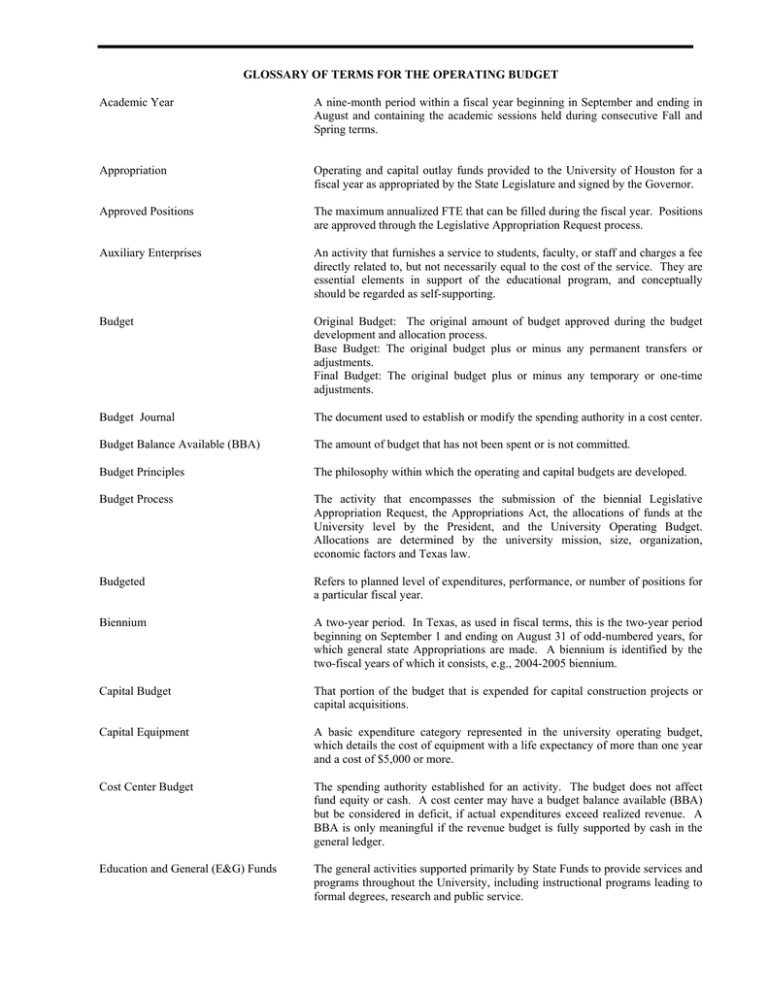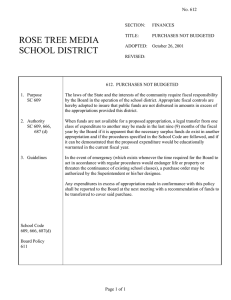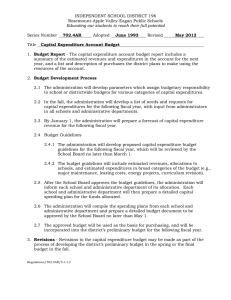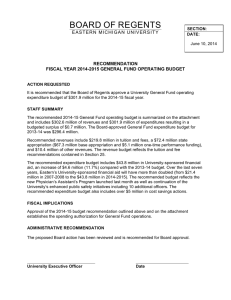Academic Year
advertisement

GLOSSARY OF TERMS FOR THE OPERATING BUDGET Academic Year A nine-month period within a fiscal year beginning in September and ending in August and containing the academic sessions held during consecutive Fall and Spring terms. Appropriation Operating and capital outlay funds provided to the University of Houston for a fiscal year as appropriated by the State Legislature and signed by the Governor. Approved Positions The maximum annualized FTE that can be filled during the fiscal year. Positions are approved through the Legislative Appropriation Request process. Auxiliary Enterprises An activity that furnishes a service to students, faculty, or staff and charges a fee directly related to, but not necessarily equal to the cost of the service. They are essential elements in support of the educational program, and conceptually should be regarded as self-supporting. Budget Original Budget: The original amount of budget approved during the budget development and allocation process. Base Budget: The original budget plus or minus any permanent transfers or adjustments. Final Budget: The original budget plus or minus any temporary or one-time adjustments. Budget Journal The document used to establish or modify the spending authority in a cost center. Budget Balance Available (BBA) The amount of budget that has not been spent or is not committed. Budget Principles The philosophy within which the operating and capital budgets are developed. Budget Process The activity that encompasses the submission of the biennial Legislative Appropriation Request, the Appropriations Act, the allocations of funds at the University level by the President, and the University Operating Budget. Allocations are determined by the university mission, size, organization, economic factors and Texas law. Budgeted Refers to planned level of expenditures, performance, or number of positions for a particular fiscal year. Biennium A two-year period. In Texas, as used in fiscal terms, this is the two-year period beginning on September 1 and ending on August 31 of odd-numbered years, for which general state Appropriations are made. A biennium is identified by the two-fiscal years of which it consists, e.g., 2004-2005 biennium. Capital Budget That portion of the budget that is expended for capital construction projects or capital acquisitions. Capital Equipment A basic expenditure category represented in the university operating budget, which details the cost of equipment with a life expectancy of more than one year and a cost of $5,000 or more. Cost Center Budget The spending authority established for an activity. The budget does not affect fund equity or cash. A cost center may have a budget balance available (BBA) but be considered in deficit, if actual expenditures exceed realized revenue. A BBA is only meaningful if the revenue budget is fully supported by cash in the general ledger. Education and General (E&G) Funds The general activities supported primarily by State Funds to provide services and programs throughout the University, including instructional programs leading to formal degrees, research and public service. Encumbrance A financial transaction which reserves funds for a specific purpose. Estimated Refers to estimated revenues and expenditures for the current fiscal year. Because these numbers are developed later in the fiscal year, they are considered to be more accurate than budgeted numbers. Expended Refers to actual dollars or positions utilized during a completed fiscal year. Expenditure A financial transaction which records the cost of operations. Fiscal Year A twelve-month period of time beginning in September of one calendar year and ending August 31 of the next calendar year, and specified by the calendar year in which the fiscal year ends, e.g. September 2003 through August 2004 is fiscal year 2004. Full Time Equivalent (FTE) Positions A unit of measure that represents the average number of state personnel working 40 hours a week. A nine-month faculty position (the academic year) is equal to an annual .75 FTE. A University Support Personnel or Administrative and Professional position for twelve months equal is to 1.0 FTE. Includes all faculty positions, full time exempt positions, full time classified positions, and full time hourly and seasonal positions. In addition, it includes those positions which are not full-time regular positions, but are converted to full-time equivalents. Term FTE: The Full Time equivalent which should be reported on the Personnel Action Request (PAR) for the duration of the assignment. It is equal to the standard hours per week divided by forty. Annualized FTE: Equal to the Term FTE times the duration of the assignment. The duration of the Fall or Spring semester is 4.5 months/12 months which equals 0.375. The duration of the three month summer is 3 months/12 months which equals 0.25. The Annualized FTE is the calculated amount which is reported to the State on a quarterly basis. Full Time Equivalent (FTE) Students A workload measure based on credit hours generated for each term divided by the appropriate undergraduate or graduate divisor. The divisor (one FTE) is equivalent to 15 credit hours at the undergraduate level or to 12 credit hours at the masters level or special professional level, and to 9 credit hours at the doctoral level. Fund Balance The difference between realized revenue and actual expenditures, net of any other fund additions or deductions. The fund balance is not affected by the budget or encumbrances. General Revenue Funds State funds appropriated to the University and which are used for operating funds. Higher Education Assistance Funds (HEAF) Special appropriations for eligible institutions of higher education to be used for acquisition of land, permanent improvements, construction and equipping of buildings, major repair or rehabilitation of buildings, and the acquisition of capital equipment, library books and library material. Legislative Appropriation Request (LAR) The method of submission by each state agency as a biennial budget request to the Legislative Budget Board in the year preceding the convening of the Legislature. Legislative Budget Board (LBB) The Texas Legislative Budget Board (LBB) is a permanent, joint committee of the Texas Legislature that develops recommendations for legislative appropriations for all agencies of state government. Local E &G Funds Dollars collected from students by the University, remitted to the state treasury and then reallocated to the University for expenditures on Education and General activities. Students’ tuition and matriculation fees make up the largest portion of these funds. Local Funds Funds that belong to entities of the University that are maintained in local banks rather than the State Treasury. Some student fees, Designated Tuition, time deposits, sales and services make up the largest portion of these funds. Maintenance and Operations A basic expenditure category represented in the university operating budget, which details the cost of postage, telephones, travel, consumable supplies, and non-capital equipment. Operating Budget An expenditure plan developed by a university for each fiscal year. The plan must conform to the annual allocation/appropriation and indicate estimated expenditures for the year by expenditure category. Personnel Action Request (PAR) The form used to initiate an employee change usually resulting in a payroll action. Position Request (PR) The form used to create a new position or change an existing one, frequently resulting in a budget action. Project Year A twelve-month period beginning in the first month a project cost center is established. A project year may not coincide with the university’s fiscal year. Recommended Budget Refers to dollar amount or number of FTE positions recommended by the institution for the subsequent fiscal year. Requested Refers to the dollar amount or number of FTE positions sought by a college or division for use during the subsequent fiscal year. Revenue Financial transaction, which records new funds received by the institution. Salaries & Benefits A basic expenditure category represented in the university operating budget, which details funds to pay faculty and salaried employees. Salary Rate An individual’s total annual rate of pay, excluding benefits. Wages A basic expenditure category represented in the university organizational budget, which details the cost of temporary employment such as Student Assistants, Graduate Assistants, Consultants, and Faculty Adjuncts.



